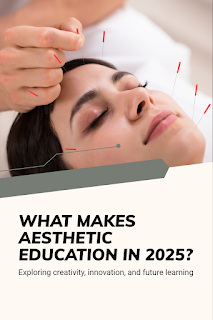In the past, aesthetic training often followed a predictable path: some theory, some practice, then straight into procedures. That formula has served well enough for years. But 2025 is demanding more. Patients are more informed, competition is steeper, and the landscape of treatments and technologies is expanding at a dizzying pace. Aesthetic professionals need more than just hands-on skills—they need a wider lens.
So what exactly should an aesthetic education offer now, in this era of shifting standards and sky-high expectations?
The Shift from Technical to Holistic
It’s tempting to think aesthetic education is all about the techniques how to hold the needle, where to inject, what to do when something goes wrong. And yes, the technical foundation matters. No one wants to be treated by someone whose only qualification is a YouTube tutorial. But what separates a good practitioner from a sought-after one in 2025 isn’t just clinical skill. It’s the ability to understand skin health in the context of lifestyle, to build rapport with a nervous first-timer, and to navigate an industry where regulation lags behind innovation.
This is where curriculum design becomes crucial. A good aesthetic program won’t just drill procedures. It’ll introduce students to the ethics of consent, the nuances of skin of colour, and the realities of working in under-regulated environments. The how is still important but the why and when are just as vital.
Why Flexibility and Breadth of Courses Matter
If you’re looking to specialise or branch out, say, into microneedling, chemical peels, or advanced injectables, then a narrow training path just won’t cut it anymore. Aesthetic education needs to offer breadth, depth, and adaptability. This means looking for programs that allow you to explore different modalities, keep up with evolving techniques, and fine-tune your expertise over time.
That’s why many aspiring professionals choose to view full aesthetic training options before committing to a single course. It’s not just about checking a box for certification—it’s about building a layered understanding that can grow with the industry. From beginner foundations to advanced aesthetics, flexibility is what keeps a career from stalling five years in.
The Rise of Skin Science and Anatomy in Curriculum
Here’s the thing about injectables: they look easy. A small jab here, a plump there. But anyone who’s sat through even a single cadaver-based anatomy workshop knows how complicated the face really is. In 2025, patients aren’t just asking “Will it hurt?” They’re asking “What layer are you injecting into?” and “What are the risks to my facial artery?”
Programs that treat anatomy as a dry preamble to the ‘real’ work are behind the curve. Courses that integrate practical anatomy, especially with 3D visuals or dissection-led module,s give practitioners the confidence and credibility they need. And clients notice.
There’s also a growing emphasis on skin health as the basis for all treatments. After all, what’s the point of filler if the skin’s dehydrated and inflamed? Expect to see more overlap between medical-grade skincare, nutrition, and aesthetic interventions in education moving forward.
Beyond the Needle: Client Care and Consultation
Soft skills are still wildly underrated in aesthetic training. Yet most experienced practitioners will tell you: one bad consultation can ruin everything. A well-rounded education doesn’t just teach how to consult—it teaches how to listen.
That includes identifying red flags like body dysmorphia, managing unrealistic expectations, and knowing when to say no. It’s easy to forget that “doing nothing” is sometimes the best treatment plan. Ethical practice should never be an optional module.
And communication goes beyond the consultation room. Post-treatment care, managing reactions (both physical and emotional), and building long-term relationships with clients all require skill. These aren’t just nice-to-haves; they’re core competencies.
Keeping Pace with Trends Without Losing Integrity
Trends will come and go. One month it’s “baby Botox,” the next it’s “skin boosters” or “fox eyes.” A solid aesthetic education doesn’t chase fads; it teaches how to evaluate them. That includes understanding the science (or lack thereof), assessing long-term outcomes, and balancing commercial appeal with patient safety.
Practitioners who thrive are the ones who can say, “Yes, that’s popular—but here’s what we know about its safety, and here’s what might be more suitable for your face.” That level of authority doesn’t come from Instagram it comes from training.
This is also where continuous professional development comes in. A one-off course can only take you so far. The best programs embed a culture of lifelong learning because in aesthetics, yesterday’s innovation can quickly become today’s malpractice.
So, What Should You Look For?
There’s no universal checklist, but a few questions can help narrow the field:
Does the program offer both theory and practice?
Are the trainers actively working in the field?
Is there a pathway for progression from beginner to advanced?
Are ethics and patient safety core to the curriculum?
Is the course aligned with current industry standards (and are those standards even clear in your region)?
No program is perfect, and the best education often comes from a patchwork of learning—formal, informal, hands-on, peer-to-peer. But the goal is to be well-rounded, not rushed. And in 2025, that means looking for education that respects the full complexity of the work not just the pretty results on a client’s face.
Final Thoughts
Aesthetic training in 2025 is no longer about memorising a technique and hitting the ground running. It’s about thinking critically, learning continuously, and recognising that each face you treat comes with its own unique story. The best education doesn’t just teach you how to inject, it teaches you how to see.
Done right, it’s a career that blends science, art, and empathy. And for those willing to take the time to learn it properly, that’s a powerful combination.

















No comments